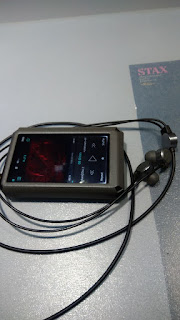Bang to Buck? Hmm...close enough.
I'm going to be...extremely upfront about this.
I never cared too much about Opus players. They just don't pique my interest enough when I first looked at them. If anything, on first appearance impression alone I just see them as nothing more than cheap AK players wannabe for those who want to save some cash but still can't afford the actual AK player they desire.
Even holding the player alone seemed to make me feel like I am holding a slab of cheap steel and plastic mixed in together, and it didn't help that the button feedback was a little flimsy for something that cost as much as MYR 2399 and can't seem to have snappy buttons like the cheaper Fiio X3 II or X5 II.
But after several months passed as they announced the new Opus 1S, I got curious and returned to give a proper level of attention to the Opus #1 that I once dismissed so unjustly from appearance alone.
My thought was -- "Why would they release another version of this? Was there something good inside that I never gave a chance and it would mean I miss out something crucial?"
And that's where it brought me back to this model.
Usability
With an internal memory of 32 GB, and dual microSD card slots of 200GB compatibility each, raking in a total of 464 GB total, the Opus #1 is more than capable of holding a lot of lossless music tracks.
The user interface on the Opus is nothing short of user-friendly. It's very easy to use and pick up.
And it's also very responsive -- which makes breezing through music folders effortless and hassle-free.
While I don't use the EQ function myself, it does seem adequate enough for basic use from what I examined briefly.
One thing I am not happy however -- is the terrible screen. There's no delicate way to put it on a DAP that priced over MYR 2000. Put next to the Fiio X5 II again, the supposedly larger touch-screen on the Opus #1 just feels very cheaply made.
The backlighting on the screen is just poor and very uneven. Color disorientation on angle viewing is so obvious that you might question the quality of the screen on something this expensive when you could see similar screen quality from smartphones that are priced far cheaper like the Xiao Mi phones.
This -- I am certain. The screen on this device is not a worthy screen for a device priced as steep as MYR 2399.
Thankfully however, the performance on the player is top notch.
Powered by the ARM Cortex-A9 1.4 GhZ quad-core CPU processor and 1GB DDR3 RAM under its hood running on an Android-based OS, the player is very responsive to touch feedback and there's very minimal lag.
Sound
This is where I can say "Now this is more like it."
Driven by the Cirrus Logic CS4398 24bit dual DAC-chips, tThe sound is comfy, smooth and neutral with a mild warmth added to it, which makes it a little "analog" sounding than "digital".
Tested out of the demo unit of Dita Audio's The Answer (with the original unremovable Fat Cable), the bass has very fine texture with proper depth to it. It's not a lot of quantity, if anything, it's a fine balance of quality and quantity with proper natural decay.
The positioning did took a bit of a back sit however, giving it a very relaxed and laidback feel. Listening to OMAM's Wolves Without Teeth was definitely something else, the presentation is both relaxing yet still retained that dynamic life from the chorus' instruments powerful drum hitting in contrast with the mildly slow tempo of the song.
The midrange is musical and filled with a fair amount of micro-details, and positioned not too forward that it became unbearable.
Treble however is a little bit rolled off from my ears. It extends well, but not far enough for me to consider it a strength. Then again -- this does contribute to the player sounding smoother on slow songs that has a lot of acoustic instruments or even just listening to Kenny G's jazz. The resolution on the Opus #1 is not the most out-of-this-world levels, but for this price-point, it does its job very well and plays nice on most genre.
Soundstage is wide and deep with adequate 3D imaging, and presentation overall is pretty transparent.
Driving the Dita Answer -- I hear no audible hiss even when listening to very high volume levels, so there's another plus. However, BA IEMs might not get off so easy since they are naturally a lot more sensitive to source-pairing.
My only advice is test the DAP with your IEMs first before pulling the trigger if you're sensitive to hissing.
Temporary End Words
Opus #1 has impressed me on the most important things for a DAP -- sound, and the UI-friendliness.
It's clear now that I have a fondness on this little bugger after trying it out for a few hours of listen. Now...will I buy this?
That remains up in the air, but the price of 2399 does seem like a big bargain when you put it next to premium AK DAPs like AK70 MK II, which cost MYR 3299.
Sure, the screen is a bit of an embarrassment in my personal opinion, but it's not off-putting enough to shun me off of a purchase consideration as the UI was so easy to use and its sound does impress on price point alone.
But one thing I am certain -- I will look forward to the newer Opus #1S once I get the chance to audition it.
Now...Astell&Kern...about that AK70 MKII...




No comments:
Post a Comment